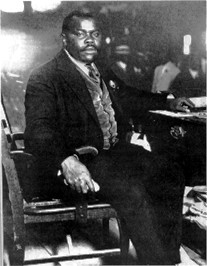 Marcus Mosiah Garvey and Marcus Mosiah Garvey and
Cuba
by Eugene Godfried, 6/04
Marcus Mosiah Garvey is the founder of the internationally known
"Universal Negro Improvement Association", abbreviated U.N.I.A. The movement’s newspaper
was "NEGRO WORLD".
Garveyism in Cuba was primarily, although not exclusively, a movement of
the British West Indian immigrants. Garveyites stimulated the West Indian
immigrants to maintain their sense of "IDENTITY" and to survive in
an often times hostile environment.
UNIA’s objective in Cuba was focused on the protection of the labor -
interest and to enhance the social well-being of immigrants from mainly
anglophone, as well as francophone and other groups in the Caribbean who
were brought to Cuba from 1910 onward in order to work on the sugar, coffee,
cocoa, and other estates. By being immigrant - centered, in that sense, the
movement was not considered a threat to public order by the eurocentric elite.
"LA CHAMBELONA UPRISING" OF 1917 – Seventeen British West
Indian workers were murdered by soldiers in Jobabo, Las Tunas. UNIA defends
Brittish West Indian immigrants against abuse by employers and labor-
recruiters in the canefields. President Mario Menocal, consequently, issued
a Presidential decree ordering repatriation of "braceros",
hand-laborers, since they were posing a threat/danger to public health and
were a public burden to the nation.
BLACK STAR LINE, founded in 1919.
Captain Joshua Cockburn piloted the Black Star steamer "FREDERICK
DOUGLAS", into Sagua La Grande, Las Villas, before continuing to Havana
in early December 1919.
At the beginning of 1921, Reverend George Alexander MacGuire, Chaplain
General of the UNIA, became the first member of the Association’s
executive council to make an official trip to Cuba. Before returning to New
York in early March 1921, he visited a dozen (12) divisions in Cuba, sold
Black Star stock, and collected contributions to the Liberian Construction
Loan.
Marcus Garvey visited Cuba in 1921:
Marcus Garvey arrived in Cuba in March 1921, along with HENRIETTA VINTON
DAVIS, and JOHN SIDNEY DE BOURG (UNIA’s international organizers).
1927: Fifty (50) Cuban chapters’ are registered with the UNIA parent
body in New York, U.S.A.
Garveyite leaders in Cuba gave social assistance to immigrants during
economic crash of the 1920’s. The Movement in Cuba then urged the British
government to provide better support for its West Indian subjects living in
Cuba.
Because of internal conditions of the movement outside of Cuba, it is
noticeable that the movement gradually disappeared in Cuba in the decade of the 30's.
Marcus Garvey died in 1940.
The ideas of Marcus Mosiah Garvey were of great interest to the later to
be formed Rasta movement in Jamaica, therefore he was a predecessor to the
Rastas.
The Rasta movement has a significant presence in present day Cuba, thanks
to the work done and examples set forth by Robert Nesta "Bob"
Marley, who is adored by a cross section of the Cuban youth and people.
|



